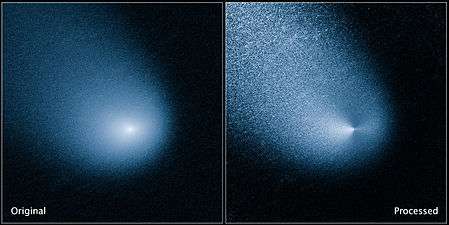Kepler-419b
| Exoplanet | List of exoplanets | |
|---|---|---|
| Parent star | ||
| Star | Kepler-419 (KOI-1474) | |
| Constellation | Cygnus | |
| Right ascension | (α) | 19h 41m 40.3s |
| Declination | (δ) | +51° 11′ 05.15″ |
| Apparent magnitude | (mV) | 13[1] |
| Distance | 2544 ly (780[2] pc) | |
| Spectral type | F?V[3] | |
| Mass | (m) | 1.39 (± 0.08)[3] M☉ |
| Radius | (r) | 1.75 (± 0.08)[3] R☉ |
| Temperature | (T) | 6430 (± 79)[3] K |
| Metallicity | [Fe/H] | 0.176 (± 0.07)[3] |
| Age | 2.8 (± 1.3)[4] Gyr | |
| Physical characteristics | ||
| Mass | (m) | 2.5 (± 0.3)[3] MJ |
| Radius | (r) | 0.96 (± 0.12)[3] RJ |
| Stellar flux | (F⊙) | 34.66 ⊕ |
| Temperature | (T) | 505 K (232 °C; 449 °F) |
| Orbital elements | ||
| Semi-major axis | (a) | 0.37 (± 0.007)[3] AU |
| Eccentricity | (e) | 0.833 (± 0.013)[3] |
| Orbital period | (P) | 69.7546 (± 0.0007)[3] d |
| Inclination | (i) | 88.95+0.14 −0.17[3]° |
| Discovery information | ||
| Discovery date | 2012 (dubious) 12 June 2014 (confirmed)[3] | |
| Discoverer(s) | Kepler spacecraft | |
| Discovery method | Transit method[3] | |
| Discovery status | Published | |
| Other designations | ||
| KOI-1474.01, KIC 12365184 b, WISE J194140.29+511105.1 b, 2MASS J19414029+5111051 b | ||
| Database references | ||
| Extrasolar Planets Encyclopaedia | data | |
| SIMBAD | data | |
| Exoplanet Archive | data | |
| Open Exoplanet Catalogue | data | |
Kepler-419b (also known by its Kepler Object of Interest designation KOI-1474.01) is a hot Jupiter exoplanet orbiting the star Kepler-419, the outermost of two such planets discovered by NASA's Kepler spacecraft. It is located about 2,544 light-years (780 parsecs, or nearly 2.4068×1016 km) from Earth in the constellation Cygnus.[3] The exoplanet was found by using the transit method, in which the dimming effect that a planet causes as it crosses in front of its star is measured.
Characteristics
Mass, radius and temperature
Kepler-419b is a hot Jupiter, an exoplanet that has a radius and mass near that of the planet Jupiter, but with an extremely high temperature. It has a temperature of 505 K (232 °C; 449 °F).[5] It has a mass of 2.5 MJ and a radius of 0.96 RJ.
Host star
The planet orbits an (F-type) star named Kepler-419. The star has a mass of 1.39 M☉ and a radius 1.75 R☉. It has a surface temperatures of 6430 K and is 2.8 billion years old. In comparison, the Sun is about 4.6 billion years old[6] and has a surface temperature of 5778 K.[7]
The star's apparent magnitude, or how bright it appears from Earth's perspective, is 13. It is too dim to be seen with the naked eye.
Orbit
Kepler-419c orbits its host star with 270% of the Sun's luminosity (2.7 L☉) about every 67 days at a distance of 0.37 AU (close to the orbital distance of Mercury from the Sun, which is 0.38 AU). It has a highly eccentric orbit, with an eccentricity of 0.833.
Discovery
In 2009, NASA's Kepler spacecraft was completing observing stars on its photometer, the instrument it uses to detect transit events, in which a planet crosses in front of and dims its host star for a brief and roughly regular period of time. In this last test, Kepler observed 50000 stars in the Kepler Input Catalog, including Kepler-419, the preliminary light curves were sent to the Kepler science team for analysis, who chose obvious planetary companions from the bunch for follow-up at observatories. Observations for the potential exoplanet candidates took place between 13 May 2009 and 17 March 2012. After observing the respective transits, the first planet, Kepler-419b, was announced.
References
- ↑ Kepler Mission Team (2009). "VizieR Online Data Catalog: Kepler Input Catalog (Kepler Mission Team, 2009)". VizieR On-line Data Catalog: V/133. Originally published in: 2009yCat.5133....0K. 5133. Bibcode:2009yCat.5133....0K.
- ↑ Dawson, Rebekah I.; Johnson, John Asher; Morton, Timothy D.; Crepp, Justin R.; Fabrycky, Daniel C.; Murray-Clay, Ruth A.; Howard, Andrew W. (2012). "The Photoeccentric Effect and Proto-hot Jupiters. II. KOI-1474.01, a Candidate Eccentric Planet Perturbed by an Unseen Companion". The Astrophysical Journal. 761 (2): 163. arXiv:1206.5579
 . Bibcode:2012ApJ...761..163D. doi:10.1088/0004-637X/761/2/163.
. Bibcode:2012ApJ...761..163D. doi:10.1088/0004-637X/761/2/163. - 1 2 3 4 5 6 7 8 9 10 11 12 13 14 Dawson, Rebekah I.; John Asher Johnson; Fabrycky, Daniel C.; Foreman-Mackey, Daniel; Murray-Clay, Ruth A.; Buchhave, Lars A.; Cargile, Phillip A.; Clubb, Kelsey I.; Fulton, Benjamin J.; Hebb, Leslie; Howard, Andrew W.; Huber, Daniel; Shporer, Avi; Valenti, Jeff A. (2014). "Large eccentricity, low mutual inclination: The three-dimensional architecture of a hierarchical system of giant planets". The Astrophysical Journal. 791 (2): 89. arXiv:1405.5229
 . doi:10.1088/0004-637X/791/2/89.
. doi:10.1088/0004-637X/791/2/89. - ↑ "Notes for planet Kepler-419 c". The Extrasolar Planets Encyclopedia. Retrieved August 8, 2016.
- ↑ http://www.hpcf.upr.edu/~abel/phl/hec_plots/hec_orbit/hec_orbit_Kepler-419_b.png
- ↑ Fraser Cain (16 September 2008). "How Old is the Sun?". Universe Today. Retrieved 19 February 2011.
- ↑ Fraser Cain (September 15, 2008). "Temperature of the Sun". Universe Today. Retrieved 19 February 2011.
External links
- NASA – Kepler Mission.
- NASA – Kepler Discoveries – Summary Table.
- NASA – Kepler-419b at The NASA Exoplanet Archive.
- NASA – Kepler-419b at The Exoplanet Data Explorer.
- NASA – Kepler-419b at The Extrasolar Planets Encyclopaedia.
Coordinates: ![]() 19h 41m 40.3s, +51° 11′ 05.15″
19h 41m 40.3s, +51° 11′ 05.15″


